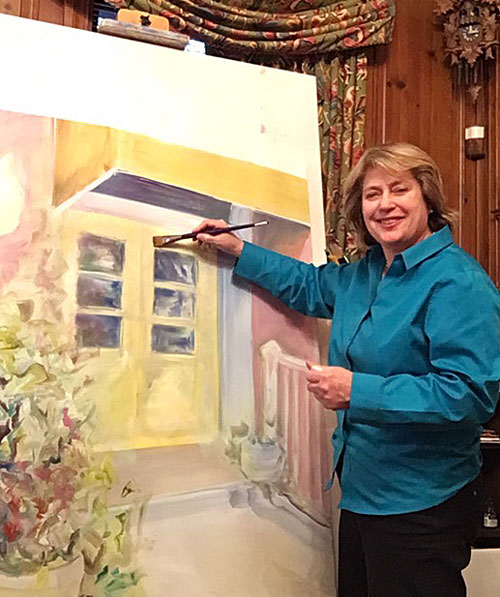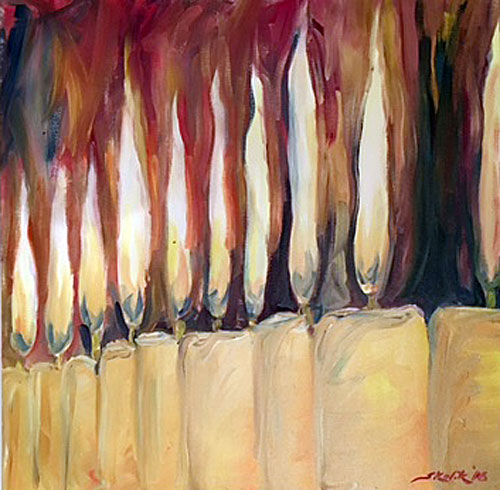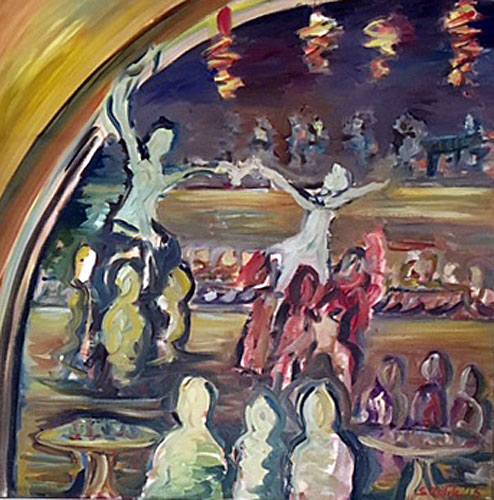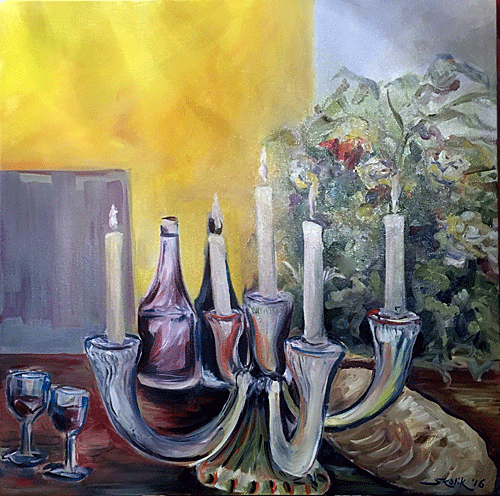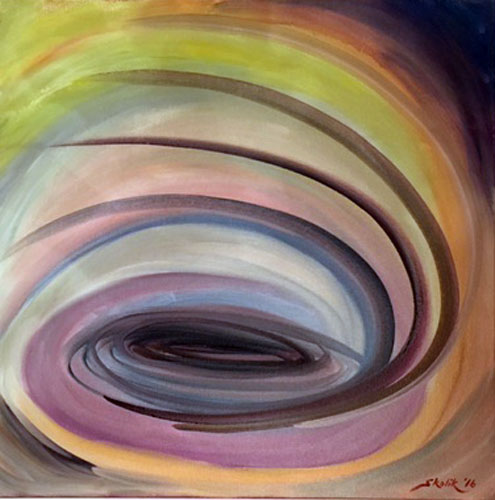Art, // January 23, 2017
Stephanie Skolik — ARTIST
Interview with the artist Stephanie Skolik —
Lewinson Art is organizing two exhibitions for the artist Stephanie Skolik. The first one will take place in the Jewish Sport Center in Mexico, on the 14th of February. The second will be in the Cultural Institute Mexico- Israel, on the 5th of March.
This interview was conducted by Débora Lewinson.
1) Where are you from?
I was born and raised in West Virginia. My grandparents immigrated to first Canada then the United States from Europe
2) How did you get started in art?
I was always interested in arts and painting. I taught myself to knit when I was just 3 years old from a book my mother gave me. By six I was painting often and in school I remember the teachers would often take my paintings to the principal in rather an astonished awareness that I understood perspective even at six. I always painted since then. When it came time to pick a permanent “career” I chose to become a physician and to specialize in retina surgery, but have always continued to paint. Indeed, I have been painting almost everyday for years and years.
3) Tell us some interesting experiences of your life as an artist?
When I was already a physician, I wondered if perhaps I should have been a full time artist, so I took two years off from being a physician to paint. I found that although I enjoyed painting I needed the human contact and schedule of the life of a physician. So, after two years when I was getting offers for shows in D.C. and New York, I refused them and went back to working as a doctor and continuing to paint for my own pleasure. I felt sure that, that combination was right for me. I continued to paint, almost each day then for almost 30 years until two years ago when a patient seeing my work on the walls of the waiting room of my office, which had and has become a sort of impromptu gallery asked me to have a show at the local museum of art. I agreed and in November of 2014 my one woman show opened at the Huntington Museum of Art, West Virginia. I spent time with a professional clay artist who tutored me in some of the intricacies of working with clay. So blind people will feel and touch my bio-reliefs clay art works, and imagine the painting I have done. Born were the “clays” that I presented at my one woman show from November 2014 through February 2015, at the Huntington Museum of Art. The show included some 60 paintings and clays and the opening was spectacular with over 500 people attending including the local TV station.
Some 10,000 people came through the show including 3,500 grade school children who were asked to turn their backs to the paintings, listen to the description and imagine what the painting must look like. This was probably the first experience for many of these children to imagine what it might be like to have trouble with a sense, like being blind. I think this sort of “empathy experience” enriches all of us as we imagine what struggles other people face and it enhances our understanding and appreciation of art to link the visual with the tactile sensation.
This experience, the making of that show, led me to further develop my philosophy behind my art. I want to expand the experience of “seeing” visual art to combine “seeing and feeling, tactile sensation” and even soon auditory representations of visual art work to help all of us use our senses in a synergistic manner to enhance the total experience. I have gone on to have other visual/tactile shows in Norwalk, Connecticut, Morgantown, WV (at West Virginia University) and at NASA’s Space Camp in Huntsville, Alabama in the last year or so. I have a one woman show opening in Brussels at the end of January 2017 sponsored by the city government of Brussels and the Fund of Belgian Society of Ophthalmology (FRO). This show will have 35 paintings and clays presented in a similar fashion.
It is my hope to bring this multisensory show to Mexico City with the same enthusiasm. My intent is to expand our usual accepted concept of our sense in isolation, to combine visual and tactile to reach parts of our brains that work to understand our environment, but to do so in a novel and enhanced way. I am especially interested to present these multi-sensory shows to not only visually impaired individuals, although certainly they are one of my focuses as an outreach of my day-job as an ophthalmologist and retina surgeon. But, to expand this concept to address the large part of our population who are “otherly sensed” – people with autism, attention deficit disorders, depressions, any aspect of self-sense that makes us interface with our daily world, and to bring this as a learning and enjoyable experience to as many people as possible.
One very striking experience that stayed with me at my show in Huntington was to be touring the show with the director from New York City of the Foundation for the Blind. He was a 61 year old engineer who “felt one of my clays that was the companion piece for a painting of mine entitled “Wild Orchid.” After “feeling” the clay he turned to me and said, “I now know what an orchid looks like.” I was quite moved, and moved to continue my work both as an ophthalmologist and as a visually sensitive painter.
4. What inspires you to make an art work?
Life. Since as long as I can remember I have “seen” the world in pictures. In the 8th grade when I was maybe 13, my algebra teacher when helping me with a math problem asked me, “Do you see the world in numbers or words?” I said, “Pictures.”
5. What style do you have?
Over the years I have had many styles. I paint both in watercolor and oil, but I prefer oil as more patient and forgiving of a media. I often invoke a watercolor style or technique in some of my paintings. In general, although I have painted realism, including portraiture, I prefer paintings that start with a concrete real object especially from nature and then expand on the feeling that object evokes in me. enhances my life and perhaps theirs but for me “painting” is not a “thing” it is an act. It is the actual moment of playing with light and color. For me the painting is the process not the product. As for my current “style,” I like something between and impressionistic abstract watercolorish play of pigment and illumination‚ resulting in an image that captures the essence but more the emotion of the process.
6. Do you like to work a particular topic?
I like to work in any topic or area that catches my eye and my imagination and to begin with that and see where it takes me.
7. Which artists have influenced in your work?
I love the impressionist, Vincent van Gogh in particular and Geogia O’Keeffe. Prior to my having knowledge of their works I had already produced paintings that had some similarities to their concepts of color and line. I enjoy the style and line that Gustav Klimt brings to his work and the intensity of color and way colors bleed into each other of Andrew Wyeth.
8. What has been the public response about your work?
The offer of the show of 2014, became a complete surprise to me and had it not be offered by two members of the museum board who I knew and respected I likely would have refused. I agreed for many reasons including that I thought my art work might give some people pleasure, but then doubly so when the tactile component was developing as I knew it (the show) had a bigger purpose. I was astounded by the overwhelming success of the show and the attendance and publicity and the world-wide acclaim.
9. Do you have a favorite art work that you have done?
I have several old standard favorites that I have done over the years. Most of these works I love have within them a compelling message that for me is more than just the pigment. One work was done by me when I was 15, and I call it “The King.” It is a distorted partially abstract representation of the Edward the VI, who became king of England at the age of 9 and died at the age of 15 at Greenwich Palace on 6 July 1553. Within the body of the painting I have entwined a poem I wrote at the time about him that is written in four lines across the paintings and enmeshed in the contour.
10. What would you do to interest more people in art?
I think our world, our society is evolving and growing and that finding new ways to help people “see” our world through art in forms that combine our senses or are more respectful of the differences in sensibilities from person to person will expand the “reach” of art to encompass more people in more interesting ways. This exhibit is intended to do just that.
LINKS —
Website: www.skolikpaintings.com
En Lewinson Art estamos dedicados a promover artistas a través de exposiciones tanto individuales como colectivas en diferentes espacios. Adicionalmente contamos con esta Galería Virtual http://www.lewinsonart.com/ que nos permite difundir el arte en México y el extranjero.
Débora Lewinson es una corresponsal oficial de Arts Illustrated en la Ciudad de México



